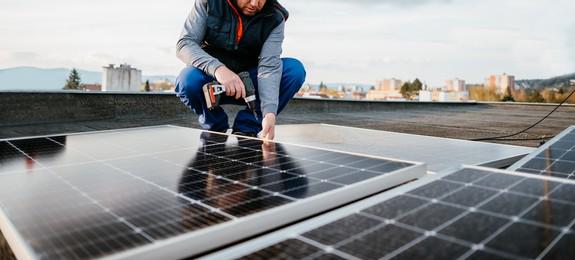
Solar panels are devices that convert sunlight into electricity. They are made of semiconductor materials like silicon. When sunlight hits a solar cell, it causes the electrons in the silicon to become excited and move around. This flow of current is directed out of the solar cell into an external circuit, where it can be used to power devices or stored in a battery. Solar panels are an environmentally friendly way to generate electricity.
Understanding Solar Cells and How They Work
Solar cells are devices that convert sunlight into electricity. They are also called photovoltaic (PV) cells. Solar cells are made of semiconductor materials, such as silicon. When sunlight hits a solar cell, it knocks electrons loose from their atoms. As electrons flow through the cell, they generate electricity. Solar cells are usually combined into modules, which are arrays of several cells wired together. Modules are then combined into arrays to create a solar power system. A solar power system can range in size from a couple of PV cells to enough arrays to power an entire city. The electricity produced by a solar cell can be used to power anything that runs on electricity, from a flashlight to a car to a power plant. Solar power is a clean, renewable resource that can help reduce our dependence on fossil fuels.
How Solar Panels Work to Generate Electricity
Solar panels are devices that convert sunlight into direct current (DC) electricity. They are called "solar" panels because most of the time, the sun's light is used to generate electricity. Solar panels can be used to power anything from small devices like calculators to large buildings. The process of converting sunlight into electricity is called the photovoltaic effect. The photovoltaic effect was discovered in 1839 by French physicist Alexandre-Edmond Becquerel. However, it wasn't until the 1950s that scientists began to develop practical applications for the photovoltaic effect. Solar panels are made up of many solar cells. Solar cells are made of semiconductor materials like silicon. When sunlight hits a solar cell, it causes the electrons in the silicon to become excited and move around. In a traditional silicon solar cell, the excited electrons would flow through the solar cell and into an external circuit, causing a current. However, the electrons would quickly be lost to thermal energy, meaning that the solar cell would not be able to generate a large enough current to be useful. To prevent the electrons from being lost to thermal energy, they are instead directed into a "P-type" layer of silicon. The P-type silicon has been exposed to an element like boron, which creates "holes" in the layer. The excited electrons from the solar cell flow into the holes, causing a current. The current from the P-type layer is then directed into an "N-type" layer of silicon. The N-type silicon has been exposed to an element like phosphorus, which creates excess electrons. The holes in the P-type layer and the excess electrons in the N-type layer cause a flow of current between the two layers. This flow of current is directed out of the solar cell into an external circuit, where it can be used to power devices or stored in a battery.
The Various Types of Solar Panels and How They Work
Solar panels are devices that convert sunlight into electricity. They are called "photovoltaic" (PV) devices. PV devices are made from materials called semiconductors, such as silicon. When sunlight strikes the PV device, electrons are knocked loose from the semiconductor material. Metal wires on the PV device collect these electrons and create an electrical current. PV devices come in many sizes and shapes, and they are used to power everything from small electronic devices to entire homes. There are two main types of solar panels: crystalline silicon and thin-film. Crystalline silicon solar panels are made from large silicon crystals (pictured on the left). They are the most common type of solar panel and typically have the highest efficiency (how much sunlight they can convert into electricity). Thin-film solar panels are made from very thin layers of semi-conducting materials (pictured on the right). They are less efficient than crystalline silicon solar panels, but they are also lighter and cheaper to produce. Solar panels are an increasingly popular way to generate electricity. They are environmentally friendly and can reduce or even eliminate your electric bill. Solar panels can be used to power your home, business, or even your car. There are many different types of solar panels, and each has its own benefits and drawbacks. The most common type of solar panel is the crystalline silicon solar panel. Crystalline silicon solar panels are made from large silicon crystals. They are very efficient at converting sunlight into electricity, but they are also the most expensive type of solar panel. Another type of solar panel is the thin-film solar panel. Thin-film solar panels are made from very thin layers of semi-conducting materials. They are less efficient than crystalline silicon solar panels, but they are also lighter and cheaper to produce. Solar panels are an environmentally friendly way to generate electricity. They can be used to power your home, business, or car. There are many different types of solar panels, and each has its own benefits and drawbacks.